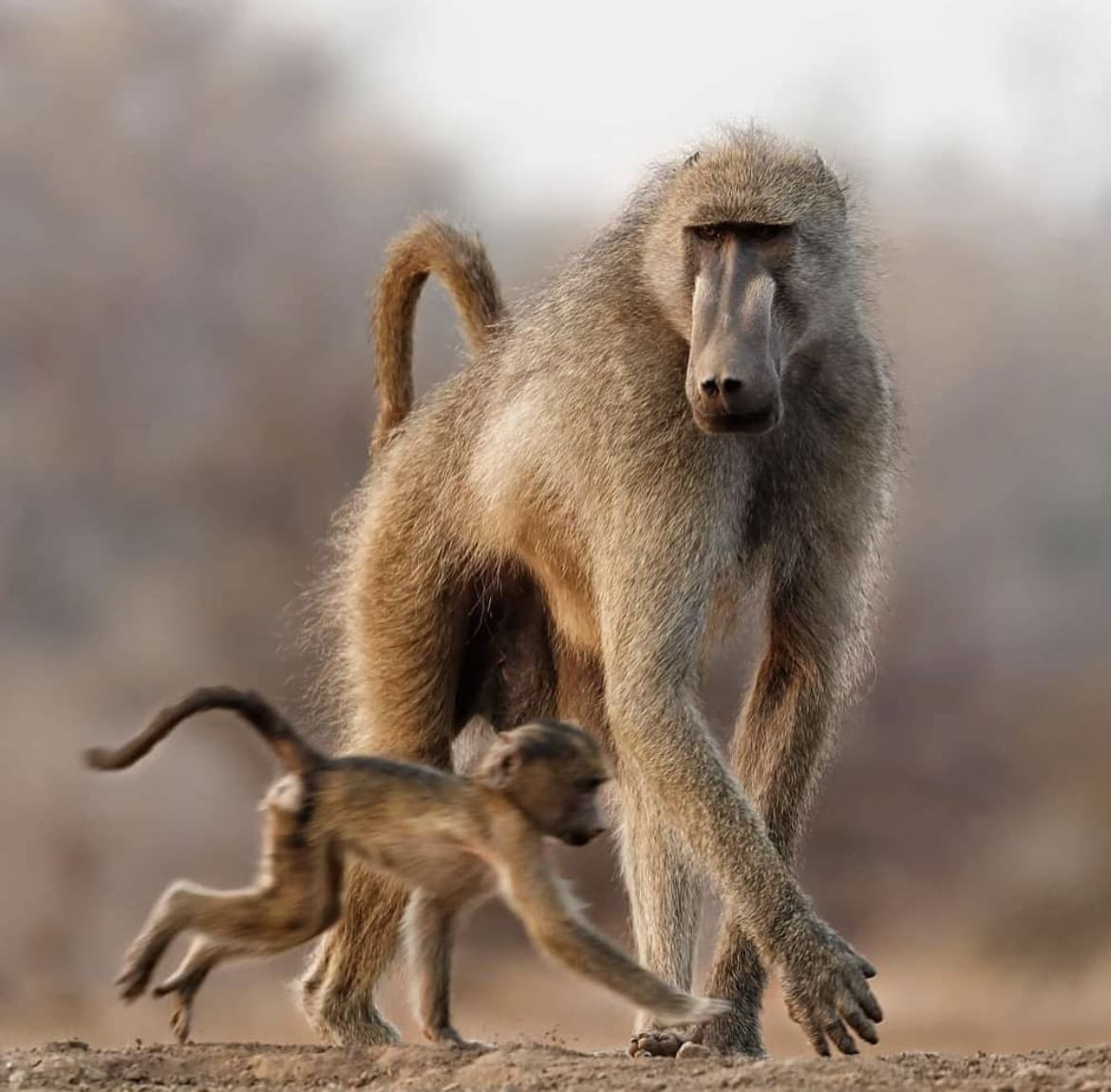Ever heard of the Gelada? No, it’s not the latest gluten-free superfood or a trendy new workout. It’s actually a fascinating primate that’s more down-to-earth—quite literally, since these guys are all about that grass-eating life.
Nestled in the breathtaking highlands of Ethiopia, Geladas are a sight to behold and a story worth diving into.
What is the Gelada?
The Gelada (Theropithecus gelada), often mistaken for your average monkey or confused with baboons, is actually a primate that marches to the beat of its own drum. These guys are the last of their kind, the sole survivors of the genus Theropithecus, and they’ve got some pretty nifty features that set them apart from their primate cousins.
For starters, they’re the world’s only grass-eating primates, which pretty much makes them the vegan hipsters of the animal kingdom. But it’s not just their diet that’s interesting; it’s their entire lifestyle. Living in the cool, rugged terrains of the Ethiopian highlands, Geladas have a social system that’s more complex than your favorite soap opera, complete with drama, alliances, and heartbreaks.
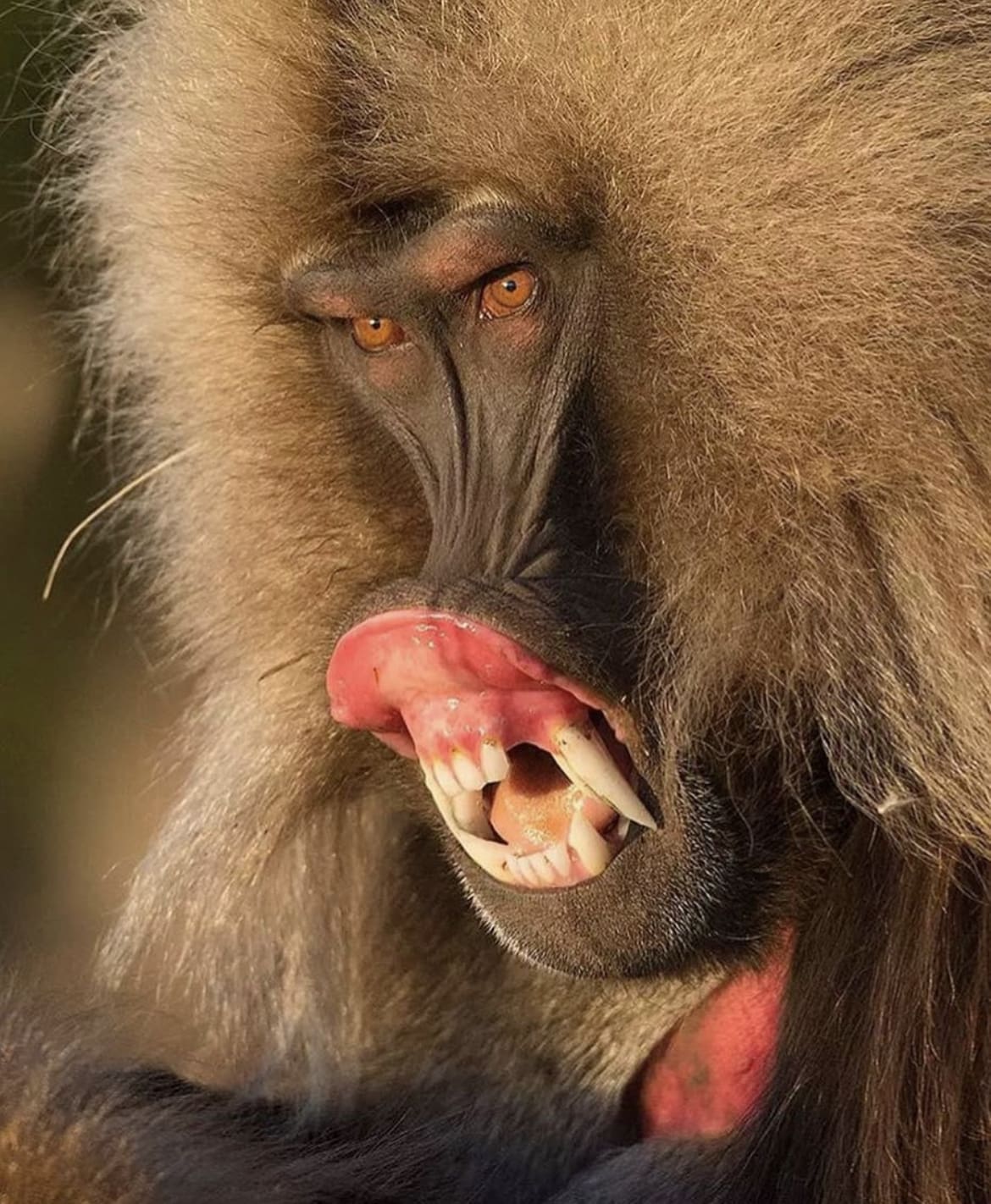
Gelada vs Baboon
Now, let’s clear up a common mix-up: Geladas vs. Baboons. At first glance, you might think, “A primate’s a primate, right?” Wrong. While Geladas might share the same zip code with some baboons in Ethiopia, the similarities pretty much end there. First off, baboons are more like the nomads of the African plains, eating a smorgasbord of fruits, insects, and occasionally other smaller animals. Geladas, on the other hand, are the zen monks of the primate world, chilling in the highlands and munching on grass.
Physically, baboons pack a more robust, muscular build, ready to face the challenges of their diverse habitats. Geladas, with their shaggier coats, are more about flaunting their impressive manes and the unique ‘bleeding heart’ on their chest—a patch of bare skin that changes color with their emotional and reproductive states. Socially, Geladas are all about community living. They form large, stable groups that can number in the hundreds, focusing on grooming, socializing, and grass-eating (of course). Baboons? They’re a bit more fluid, forming smaller troops with a hierarchy that’s always up for grabs. So, next time someone tries to lump Geladas and baboons together, you’ve got the scoop to set them straight.
What do Geladas look like?
Picture this: a primate with a heartthrob mane that would make even the most stoic of us swoon. Geladas are not your average, run-of-the-mill primates. Males boast a luxurious, thick mane that frames their face, giving them a regal, almost lion-like appearance. This isn’t just for show; it plays a critical role in their social signaling.
Their faces are framed by expressive eyes and a snout that’s less pronounced than their baboon cousins, giving them a somewhat thoughtful expression. But the real show-stopper is the chest: a patch of skin that glows a fiery red, signaling their mood and health status to friends and foes alike.
How big are Geladas?
When it comes to size, Geladas are pretty robust. Males can tip the scales at a hefty 20-30 kilograms (44-66 pounds), standing tall (well, as tall as one can on all fours) at about 50-75 centimeters (20-30 inches) at the shoulder.
Females, on the more petite side, weigh in at around 11-16 kilograms (24-35 pounds). This size difference is pretty stark, but in the world of Geladas, bigger is indeed better—at least for the males, who need to impress the females and intimidate rivals.
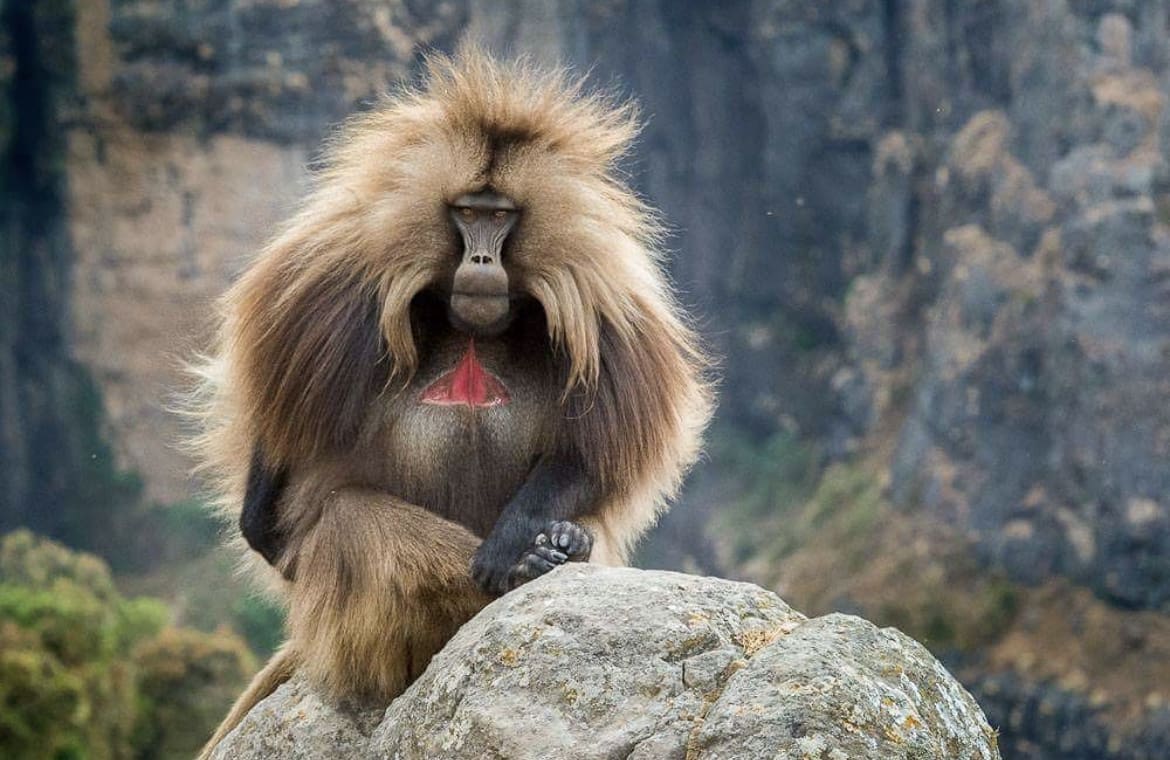
Gelada Hair
Now, let’s talk about that fabulous hairdo. Geladas take the cake for being the most stylish primates on the block, with males sporting long, flowing locks that would make any shampoo commercial jealous.
This mane isn’t just for attracting the ladies; it also serves as a status symbol among males, with the fuller, more impressive manes often belonging to the alpha of the group. But it’s not just the males who get all the hair glory; females also have a dense coat that keeps them warm in the chilly highlands.
Their hair is shorter, but it’s thick and covers their body, offering protection from the elements.
Gelada Teeth
Beneath those friendly smiles, Geladas pack a unique set of teeth. Adapted to their grass-heavy diet, their molars are flatter and more complex than those of fruit or meat-eaters, perfect for grinding down tough plant material. But it’s their canines that steal the spotlight—long and sharp, these teeth are rarely used for eating.
Instead, they’re the primates’ version of a Swiss Army knife: tools for grooming, defense, and, most impressively, social displays. A Gelada flashing its teeth isn’t necessarily aggressive; often, it’s just communicating with its peers.
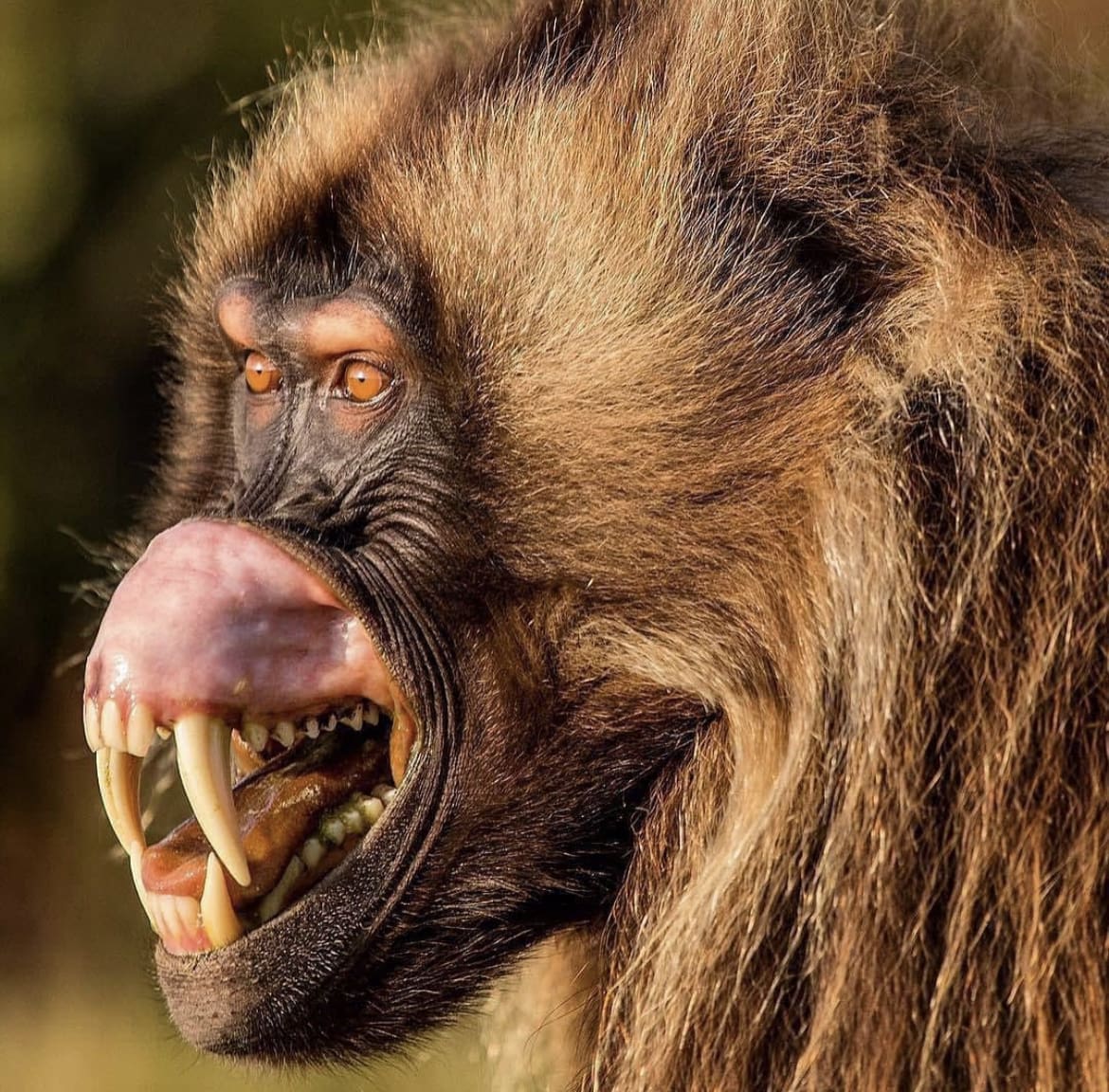
Gelada Colouration
Geladas are not just about the mane and the muscles; they’ve got a color scheme that’s worth a second look. Their overall fur is a mix of brown and grey, blending seamlessly with the rocky highlands they call home. This camouflage is nature’s gift, allowing them to evade predators with ease. But the pièce de résistance is the chest patch we mentioned earlier.
For males, this patch can turn from a pale pink to a deep, vibrant red, a sign of their hormonal status or mood. It’s like wearing their hearts on their sleeves, except it’s literally on their chests. Females have this patch too, and it becomes especially prominent during estrus, signaling their readiness for motherhood.
What do Geladas eat?
You might call Geladas the connoisseurs of the grass world. While their primate cousins are out there munching on fruits or hunting for meat, Geladas are content with a good blade of grass. But don’t let their humble diet fool you; these primates have turned grass-eating into an art form.
They spend most of their waking hours seated in the lush meadows of the Ethiopian highlands, delicately plucking grass blades with their nimble fingers. It’s a sight to behold—a peaceful gathering of primates, quietly grazing.
Their diet isn’t limited to grass, though; they occasionally supplement it with roots, fruits, and flowers, ensuring they get all the nutrients they need to thrive in their mountainous abode.
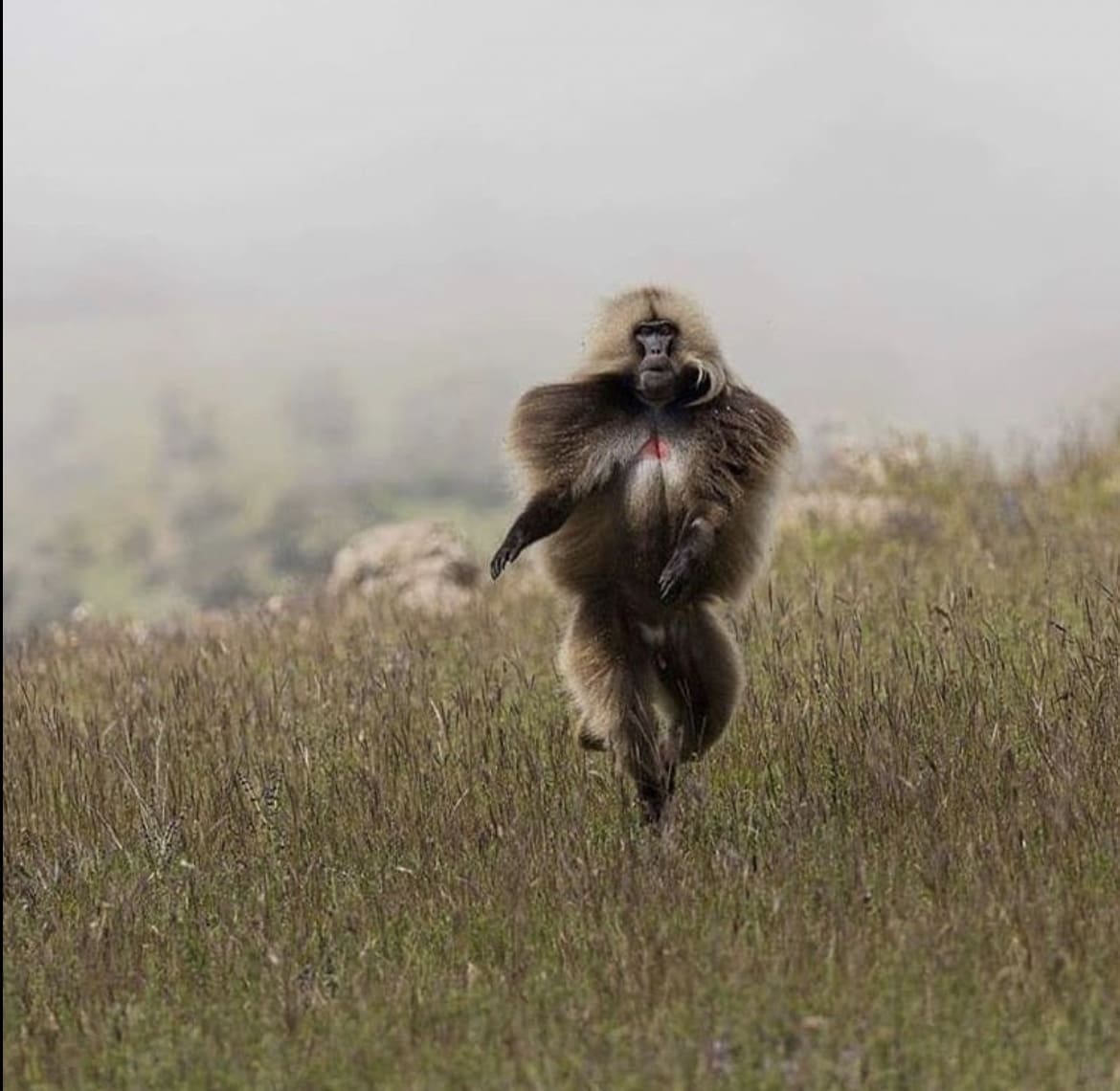
Gelada Social Structure
Imagine the most intricate, layered social network, and you’ve got a rough idea of Gelada society. It’s not just a group; it’s a complex hierarchy that ensures peace, love, and harmony among its members. At the core of this society are units typically consisting of one dominant male, several females, and their offspring. These units form the building blocks of larger bands, which can sometimes gather into communities hundreds strong during feeding or sleeping.
But it’s not all peace and quiet in Gelada land. Males outside of these units, known as bachelors, roam the fringes, waiting for a chance to challenge a dominant male for control of his harem. These power struggles are a dramatic affair, filled with displays of strength, vocal showdowns, and the occasional physical tussle. Yet, despite these conflicts, Geladas maintain a surprisingly peaceful society, with most disputes settled without serious harm.
The females, on the other hand, wield power in a more subtle way. They form strong bonds within their unit, supporting each other in raising young and even in deciding which male gets to lead. It’s a matriarchal twist in a male-dominated scene, proving that Gelada society is full of surprises.
How do Geladas reproduce?
Geladas have a unique approach to reproduction, closely tied to their social structure. The dominant male of each unit has breeding rights with the females in his group, but it’s not just about dominance; emotional bonds and social connections play a huge role. Females choose their partners based on strength, sure, but also on kindness and the ability to connect, making Gelada relationships surprisingly tender.
The mating process is often subtle, with a lot of grooming and gentle gestures leading up to it. After a gestation period of around six months, a female Gelada gives birth to a single infant. These babies are the center of attention, not just for their mothers but for the entire unit. It’s a community affair, with other females often helping to care for and protect the young. This communal care is crucial for survival and strengthens the bonds within the unit.
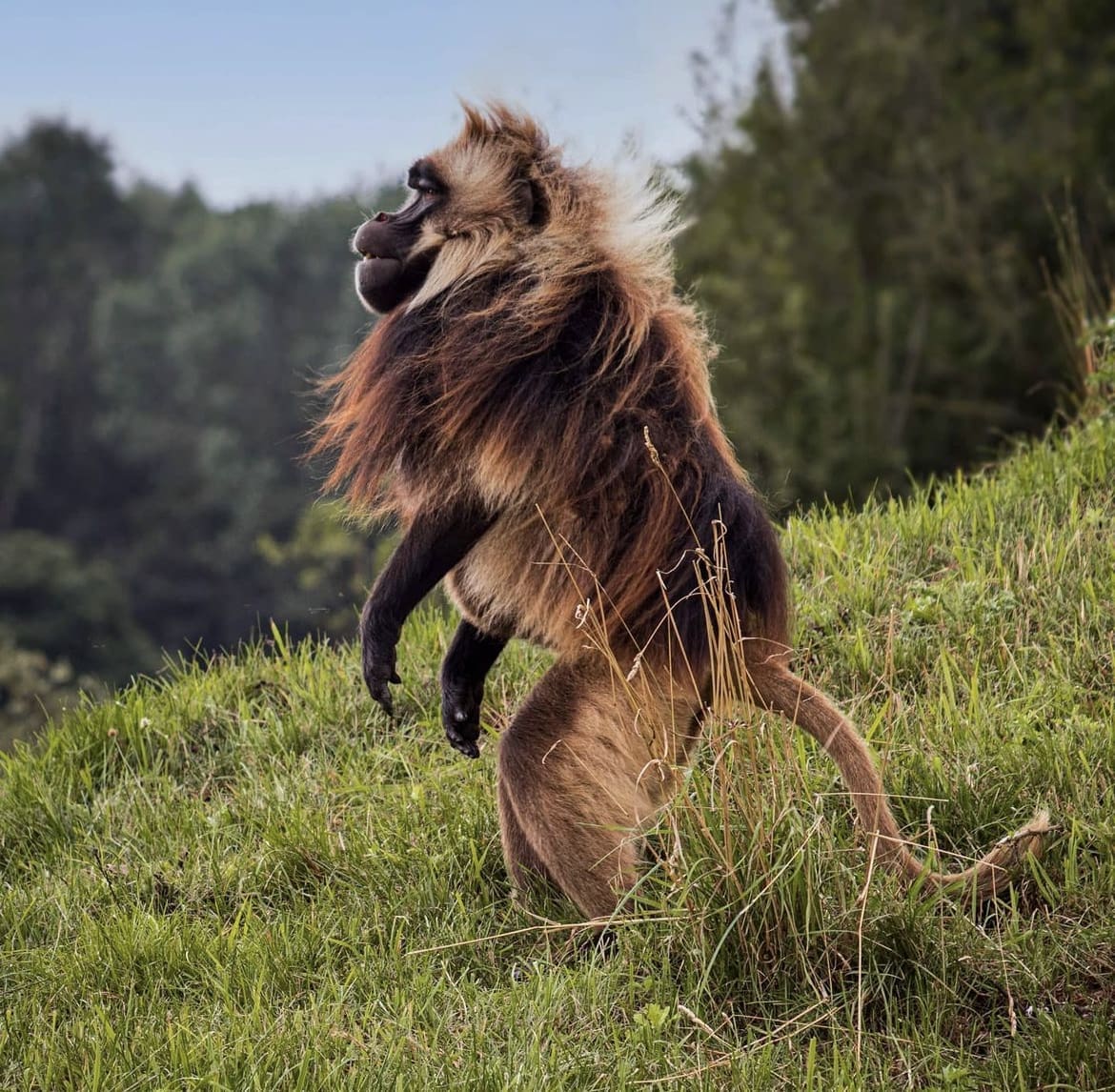
How long do Geladas live?
In the wild, Geladas can live to be quite elderly for primates, with lifespans reaching up to 20 years. This longevity is somewhat remarkable given the challenges they face, from the harsh conditions of their habitat to the internal dynamics of their social groups.
In captivity, with the absence of predators and the assurance of regular meals, Geladas can live even longer, sometimes surpassing 30 years. This extended lifespan in both environments is a testament to their resilience and the effectiveness of their social structure in providing support and safety.
Are Geladas aggressive?
The term “aggressive” might bring to mind images of fierce battles and constant strife, but for Geladas, aggression is more nuanced. Yes, males can and do get into scuffles, especially when it comes to defending their position within the group or during takeover attempts by bachelor males. These confrontations, however, are usually more about show than actual violence; a display of strength meant to intimidate rather than harm.
What’s truly fascinating is the overall peaceful nature of Gelada society. Despite the potential for conflict, Geladas generally prefer harmony. They spend a significant portion of their day grooming each other, a practice that strengthens social bonds and reduces tension. Even when disputes arise, they often resolve them through vocalizations and displays rather than physical aggression.
Are Geladas territorial?
In the grand scheme of primate behavior, territoriality can vary widely, and Geladas have their own unique take on the matter. Unlike some primates that aggressively defend vast territories, Geladas’ concept of territory is more about the space they currently occupy, particularly for feeding. These grass-eaters require large areas to sustain their groups, leading to what might be seen as a fluid territory system.
Their territories are not marked or defended aggressively against other Gelada units or species. Instead, the large, open grasslands of the Ethiopian highlands allow multiple units and even bands to overlap in their grazing areas without significant conflict. However, within a Gelada society, there is a clear understanding of personal space and social hierarchy that governs access to prime feeding and resting spots. This social regulation helps maintain order and minimizes disputes over resources.
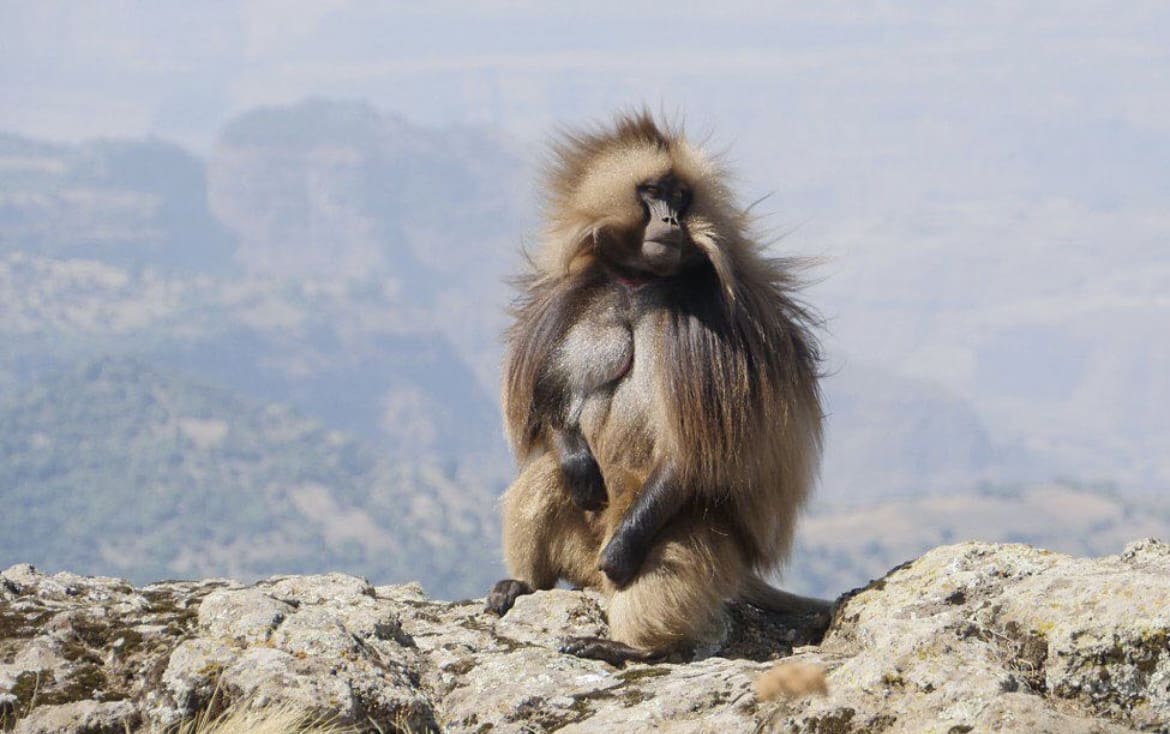
How fast are Geladas?
You might not think of speed when picturing a Gelada, given their preference for a leisurely grazing lifestyle. However, when the need arises, these primates can move surprisingly quickly. Geladas are adept at navigating the rocky terrain of their mountainous homes, capable of running and making swift escapes from predators or threats. Their speed on the ground is complemented by their ability to climb and leap among the cliffs and escarpments of the Ethiopian highlands.
While they won’t win any sprints against the savannah’s speedsters, Geladas have a remarkable agility that serves them well in their environment. This agility, combined with their social awareness, allows them to effectively manage space and safety within their groups, moving as a cohesive unit when necessary.
Where do Geladas live?
The Ethiopian highlands, a landscape as rugged as it is beautiful, is the exclusive home of the Geladas. These high-altitude grasslands, often referred to as the “roof of Africa,” provide the perfect backdrop for the Gelada’s grass-based diet and social lifestyle. The highlands offer a mix of steep cliffs, open meadows, and alpine plateaus, ranging in elevation from 1,800 to 4,400 meters (about 5,900 to 14,400 feet).
This environment not only shapes their diet and social structures but also provides natural protection from predators. The cooler climate of the highlands, combined with the terrain’s inaccessibility to many of Ethiopia’s large predators, creates a safe haven for Geladas. However, it’s not without its challenges. The highlands are a place of extremes, where temperatures can plummet, and resources can become scarce during the dry season. Geladas have adapted remarkably well to this environment, showcasing their resilience and versatility as a species.
How many Geladas are there in the wild?
Estimating the population of Geladas in the wild is a challenging task, given their habitat’s vast and rugged nature. However, recent studies suggest that there are tens of thousands of Geladas roaming the Ethiopian highlands. While this number may seem large, it’s important to note that Geladas are highly dependent on specific habitats — the grasslands of the high plateaus — which are limited in size and increasingly under threat from human activities.
Their population is relatively stable in protected areas but faces pressure in regions where their habitat overlaps with agricultural land. The exact numbers fluctuate due to environmental conditions, human encroachment, and other factors, making ongoing research and monitoring crucial for their conservation.

Are Geladas endangered?
Currently, Geladas are not classified as endangered; they are listed as “Least Concern” by the International Union for Conservation of Nature (IUCN). This status, however, should not lead to complacency. The Gelada’s habitat is under increasing pressure from agricultural expansion, grazing by livestock, and infrastructure development. These activities not only reduce their living space but also fragment their populations, making it harder for Geladas to find food and mate.
The good news is that Geladas are somewhat adaptable to changes in their environment and can coexist with low levels of human activity. Their main strongholds are in national parks and protected areas, where they are shielded from the most severe threats. Nonetheless, the situation warrants careful monitoring to ensure that “Least Concern” does not become “Endangered” in the future.
Threats to Geladas in the wild
The primary threat to Geladas comes from habitat loss and degradation, driven by the expansion of agriculture and settlements. As humans encroach further into the Ethiopian highlands, Geladas lose the grasslands they rely on for food. Additionally, competition with domestic livestock for grazing areas can lead to food shortages, particularly during the dry season when resources are scarce.
Other threats include hunting and trapping. Although Geladas are not typically hunted for bushmeat, they can be killed or captured for other reasons, such as perceived competition with livestock or for sale as pets. Climate change also poses a long-term threat, as shifts in weather patterns could alter the grasslands’ productivity and availability.

Where to See Geladas in the Wild
For those adventurous souls yearning to witness Geladas in their majestic highland kingdoms, Ethiopia offers unparalleled opportunities. The Simien Mountains National Park is perhaps the most famous locale, a UNESCO World Heritage site that boasts dramatic landscapes and rich biodiversity, including our grass-eating friends.
Here, Geladas are relatively accustomed to human presence, allowing for close-up encounters and photography. Another notable spot is the Bale Mountains National Park, offering a different but equally mesmerizing backdrop for Gelada sightings, amidst its alpine meadows and towering peaks.
Visiting these parks, you not only get a chance to observe Geladas but also contribute to local conservation efforts, as park fees and guided tour expenses support the protection of these areas and their inhabitants.
Tips for Spotting Geladas in the Wild
Spotting Geladas requires patience, respect for their natural behaviors, and a bit of know-how. Here are some tips to enhance your chances and ensure a respectful encounter:
- Early Morning or Late Afternoon: Geladas are most active and visible during the cooler parts of the day, making these ideal times for sightings.
- Stay Quiet and Unobtrusive: While Geladas may tolerate human presence, maintaining a respectful distance and minimizing noise helps avoid stressing the animals.
- Look for Large Grasslands: Given their diet, Geladas are often found in expansive grassy areas where they can be seen grazing.
- Hire a Local Guide: Not only do they know the best spots, but they also offer insights into Gelada behaviors, enhancing your experience.
Facts about The Gelada
- Geladas are the world’s only grass-eating primates, spending up to 70% of their day grazing.
- Unlike most primates, Geladas have a unique structure of their vocal cords, allowing them to produce a complex range of sounds for communication.
- The ‘bleeding-heart’ on their chest is not just for show; it signals emotional states and readiness for mating.
- Geladas can live in groups of up to several hundred, forming one of the most complex social structures among primates.
Myths about The Gelada
- Myth: Geladas are a type of baboon. Fact: While they are similar, Geladas are a distinct species, part of the genus Theropithecus.
- Myth: Geladas are aggressive towards humans. Fact: Generally, Geladas are quite peaceful and can be quite tolerant of human observers, as long as they are not threatened.
- Myth: Geladas can be easily domesticated. Fact: Despite their peaceful nature, Geladas are wild animals with specific needs and behaviors that make them unsuitable for domestic life.
Embarking on the journey to understand Geladas offers more than just insights into a unique primate species; it opens a window into the delicate balance of Ethiopia’s highland ecosystems.
Geladas are not only fascinating subjects of study due to their unique ecological niche and complex social structures but also serve as ambassadors for the conservation of the Ethiopian highlands.

